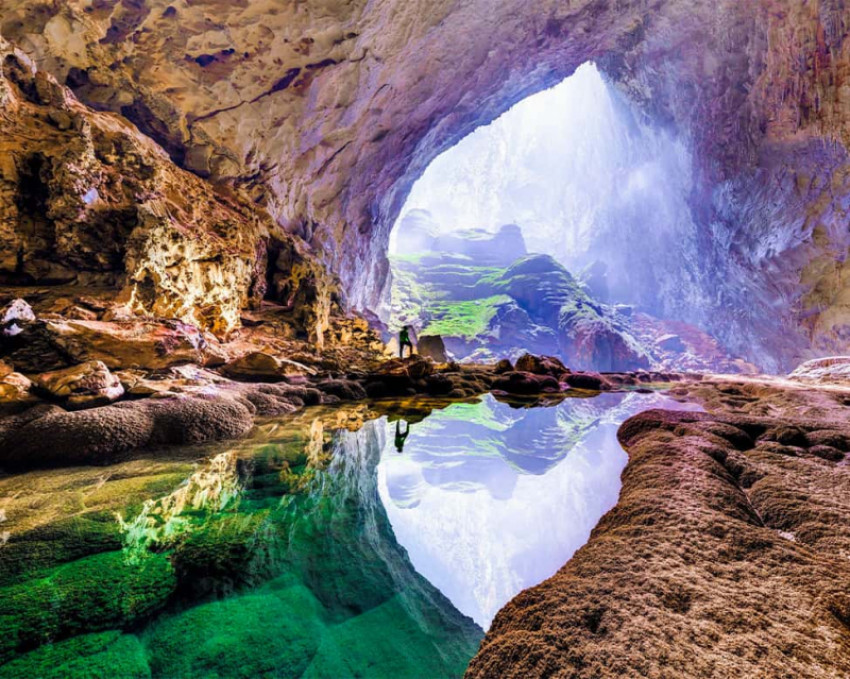
Karst topography is the movement of water within rocks, creating chemical reactions. This terrain appears a lot in rocky mountain areas, both in Vietnam and in Asia. This is one of the terrains that create famous landmarks, attracting tourists to explore.
Son Doong Cave
Son Doong Cave is known as the largest Karst cave in the world with a length of 8,573m, the highest point is 195m and the widest is up to 150m, located in the core area of Phong Nha - Ke Bang National Park. The cave is located close to the Vietnam-Laos border, and was recognized by UNESCO as a World Natural Heritage twice in 2003 and 2015. Son Doong Cave is located in Bo Trach district, Quang Binh province.
Son Doong Cave was formed about 2-5 million years ago when river water flowed through limestone areas buried along fault lines. The water eroded creating a giant tunnel in the ground beneath the mountains. In places where the rock is soft, the ceiling collapses to form a sinkhole, which over time forms a large cave dome.
Son Doong Cave has different experiences that few other caves have. Many highlights show the appeal of this cave such as:
- The Vietnam Wall (stalactite wall) is 90m high
- Campsite in the cave
- Dog's paw - natural stalactites in the cave
- Son Doong sinkhole
Ha Long Bay
Ha Long Bay is a small bay on the west coast of the Gulf of Tonkin in the Northeast sea area of Vietnam, including the island area of Ha Long city in Quang Ninh province. The entire Ha Long Bay area is a Karst landscape over many millions of years, with pyramid-shaped, eroded Karst towers, creating an outstanding and unique beauty around the world.
Thousands of islands and dozens of beautiful caves contribute to the aesthetic value of the bay. The beauty of Ha Long Bay includes three elements: rocks, water and sky. Ha Long Bay's system of rocky islands has many shapes and forms, creating a watercolor painting blending sky and sea.
The total number of plant species living on the islands of Ha Long Bay exceeds one thousand species. Many different plant communities were found, such as mangrove species, sand island plants and species growing on hillsides and cliffs, hilltops, cave mouths or crevices. Researchers from the International Union for Conservation of Nature (IUCN) have discovered 7 endemic plant species of Ha Long Bay. According to statistics, the tropical humid evergreen closed forest ecosystem in Ha Long Bay and Bai Tu Long includes: 477 species of magnolia, 12 species of ferns, 20 species of mangrove trees; Regarding animals, 4 species of amphibians, 10 species of reptiles, 40 species of birds and 14 species of mammals have been recorded.
Shilin Stone Forest
Shilin Stone Forest is a natural stone forest, located in Shilin ethnic autonomous district, Yunnan province, China. It was originally the bottom of a large sea. The water gradually dried up, revealing giant limestone mountains. Existing for millennia, the Stone Forest is the result of wind and water erosion creating impressive shapes for the rocks, a typical example of karst terrain.
Thach Lam includes 3 main areas: Greater Shilin, Little Shilin and Naigu Stone Forest
Dai Thach Lam is an area of stone pillars shaped like sword blades, some like towers, and even some shaped like pagodas and animals.
- Little Thach Lam has a characteristic gray color, different from the stone color of Dai Thach Lam, which is black with yellow spots
- Naigu Stone Forest is part of the South China Karst - a biodiverse area famous for its limestone karst that became a UNESCO World Heritage Site in 2007
Phong Nha - Ke Bang
Phong Nha - Ke Bang is part of the oldest limestone mountain area in Asia, created 400 million years ago, associated with the main tectonic and development cycles of the Earth. The area of Phong Nha - Ke Bang limestone mountain area in Quang Binh province is about 400 hectares.
Karst terrain is the most prominent feature of Phong Nha - Ke Bang limestone block, accounting for more than 2/3 of the heritage area, is the largest relatively complete limestone block in Vietnam and continues to extend to Hin Namno, Laos has become one of the most ancient and largest tropical limestone mountain regions in the world with outstanding geomorphological and geological features of global value.
Located on complex terrain in Phong Nha - Ke Bang, there is also Phong Nha - Ke Bang National Park occupying 85,754 hectares of area. Here, scientists have recorded 568 species of plants, 876 types of animals, with 133 species of large mammals, 81 species of cows and amphibians, 72 species of fish, 259 species of butterflies,...
Dong Van Karst Plateau Geopark
Dong Van Karst Plateau Geopark, also known as Dong Van Karst Plateau, is a stone plateau distributed in four districts of Quan Ba, Yen Minh, Dong Van and Meo Vac in Ha Giang province, Vietnam. Dong Van Stone Plateau has an area of 2,356.8 km2 and an average altitude of about 1,400 - 1,600m above sea level. More than 90% of the area of the plateau is limestone mountains, typical of karst terrain. with sharp mountain ranges, deep and narrow ravines, quite steep slopes, and many divided valleys, rivers, and streams... The entire surface area of the plateau is still in the process of weathered, magnificent landscape with "stone trees" forming a "stone forest".
Many fossil specimens of species have been found that are 400 - 600 million years old. According to the assessment of UNESCO's GGN Global Geopark Network Advisory Council, Dong Van Karst Plateau is one of the special limestone mountain areas, containing typical historical marks of the development process. Earth's crust, natural phenomena, unique aesthetic landscapes, high biodiversity and long-standing cultural traditions of indigenous communities. On October 3, 2010, the plateau was officially recognized as a World Geopark by the Advisory Committee of the World Geopark Network.







